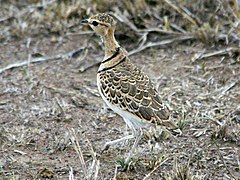Rhinoptilus
| Rhinoptilus[1] | |||
| Strickland, 1852[2] | |||
 Przedstawiciel rodzaju – nocobieg dwuobrożny (R. africanus) | |||
| Systematyka | |||
| Domena | |||
|---|---|---|---|
| Królestwo | |||
| Typ | |||
| Podtyp | |||
| Gromada | |||
| Podgromada | |||
| Infragromada | |||
| Rząd | |||
| Podrząd | |||
| Parvordo | |||
| Nadrodzina | |||
| Rodzina | |||
| Rodzaj |
Rhinoptilus | ||
| Typ nomenklatoryczny | |||
|
Cursorius chalcopterus Temminck, 1824 | |||
| Synonimy | |||
|
| |||
| Gatunki | |||
| |||
Rhinoptilus – rodzaj ptaków z rodziny żwirowcowatych (Glareolidae).
Zasięg występowania[edytuj | edytuj kod]
Rodzaj obejmuje gatunki występujące w Afryce i w Indiach[7].
Morfologia[edytuj | edytuj kod]
Długość ciała 20–29 cm, rozpiętość skrzydeł do 58 cm; masa ciała 69–220 g[7].
Systematyka[edytuj | edytuj kod]
Etymologia[edytuj | edytuj kod]
- Macrotarsius: gr. μακρος makros „długi”; nowołac. tarsus „goleń, noga”, od gr. ταρσος tarsos „podeszwa stopy”[8].
- Rhinoptilus: gr. ῥις rhis, ῥινος rhinos „nozdrza”; πτιλον ptilon „pióro”[8]. Nowa nazwa dla Macrotarsius Blyth, 1848.
- Chalcopterus: epitet gatunkowy Cursorius chalcopterus Temminck, 1824; gr. χαλκοπτερος khalkopteros „ze skrzydłami o metalicznym odcieniu, brązowoskrzydły”, od χαλκος khalkos „brąz, miedź”; -πτερος -pteros „-skrzydły”, od πτερον pteron „skrzydło”[8]. Gatunek typowy: Cursorius chalcopterus Temminck, 1824.
- Hemerodromus: gr. ἡμεροδρομος hēmerodromos „długodystansowy biegacz, kurier”, od ἡμερα hēmera „dzień”; δρομος dromos „bieganie”, od τρεχω trekhō „biegać”[8]. Gatunek typowy: Hemerodromus cinctus von Heuglin, 1863.
- Smutsornis: marszałek polny Jan Christiaan Smuts (1870–1950), południowoafrykański polityk, pisarz, filozof, premier w latach 1919–1924 i 1939–1948; gr. ορνις ornis, ορνιθος ornithos „ptak”[8]. Gatunek typowy: Cursorius africanus Temminck, 1807.
Podział systematyczny[edytuj | edytuj kod]
Takson o niejasnym pokrewieństwie w stosunku do innych taksonów z rodziny Glareolidae[9]. Do rodzaju należą następujące gatunki[9]:
- Rhinoptilus africanus (Temminck, 1807) – nocobieg dwuobrożny
- Rhinoptilus cinctus (von Heuglin, 1863) – nocobieg ozdobny
- Rhinoptilus chalcopterus (Temminck, 1824) – nocobieg czerwononogi
- Rhinoptilus bitorquatus (Blyth, 1848) – nocobieg rdzawogardły
Przypisy[edytuj | edytuj kod]
- ↑ Rhinoptilus, [w:] Integrated Taxonomic Information System (ang.).
- ↑ H.E. Strickland. List of Birds procured in Kordofan by Mr. J. Petherick. „Proceedings of the Zoological Society of London”. 18, s. 220, 1852. (ang.).
- ↑ E. Blyth. Report of Curator Zoological Department. „The Journal of the Asiatic Society of Bengal”. 17 (1), s. 254, 1848. (ang.).
- ↑ H.G.L. Reichenbach: Avium systema naturale. Das natürliche system der vögel mit hundert tafeln grösstentheils original-abbildungen der bis jetzt entdecken fast zwölfhundert typischen formen. Vorlaüfer einer iconographie der arten der vögel aller welttheile. Dresden und Leipzig: Expedition der vollständigsten naturgeschichte, 1850, s. xxx. (niem.).
- ↑ T. von Heuglin. Description of a new African Plover. „The Ibis”. 5, s. 31, 1863. (ang. • łac.).
- ↑ A. Roberts. Review of the Nomenclature of South African Birds. „Annals of the Transvaal Museum”. 8, s. 202, 1922. (ang.).
- ↑ a b G.L. Maclean: Family Glareolidae (Coursers and Pratincoles). W: J. del Hoyo, A. Elliott & J. Sargatal: Handbook of the Birds of the World. Cz. 3: Hoatzin to Auks. Barcelona: Lynx Edicions, 1996, s. 378–379. ISBN 84-87334-20-2. (ang.).
- ↑ a b c d e Etymologia za: The Key to Scientific Names, J.A. Jobling (red.), [w:] Birds of the World, S.M. Billerman et al. (red.), Cornell Lab of Ornithology, Ithaca (ang.).
- ↑ a b Systematyka i nazwy polskie za: P. Mielczarek & M. Kuziemko: Rodzina: Glareolidae Brehm,CL, 1831 - żwirowcowate - Coursers and pratincoles (Wersja: 2015-09-05). [w:] Kompletna lista ptaków świata [on-line]. Instytut Nauk o Środowisku Uniwersytetu Jagiellońskiego. [dostęp 2020-01-29].
